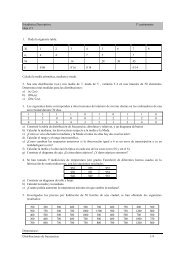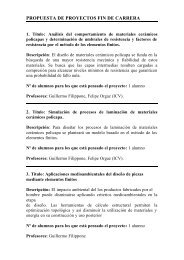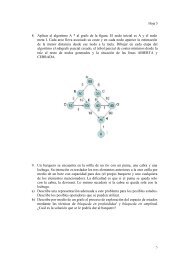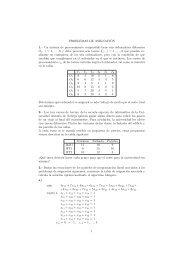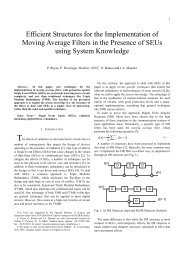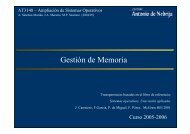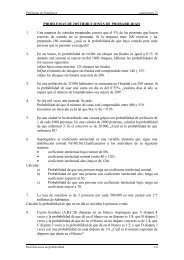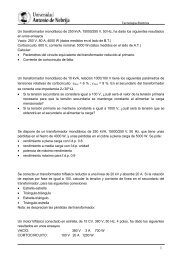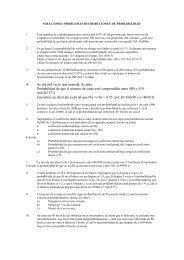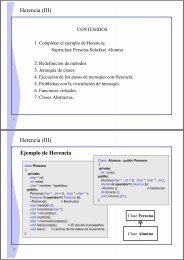A Method to Construct Low Delay Single Error ... - IEEE Xplore
A Method to Construct Low Delay Single Error ... - IEEE Xplore
A Method to Construct Low Delay Single Error ... - IEEE Xplore
You also want an ePaper? Increase the reach of your titles
YUMPU automatically turns print PDFs into web optimized ePapers that Google loves.
<strong>IEEE</strong> TRANSACTIONS ON COMPUTER-AIDED DESIGN OF INTEGRATED CIRCUITS AND SYSTEMS, VOL. 32, NO. 3, MARCH 2013 479Short PaperA <strong>Method</strong> <strong>to</strong> <strong>Construct</strong> <strong>Low</strong> <strong>Delay</strong> <strong>Single</strong> <strong>Error</strong>Correction Codes for ProtectingData Bits OnlyPedro Reviriego, Salva<strong>to</strong>re Pontarelli, Juan An<strong>to</strong>nio Maestro, andMarco OttaviAbstract—<strong>Error</strong> correction codes (ECCs) have been used for decades<strong>to</strong> protect memories from soft errors. <strong>Single</strong> error correction (SEC) codesthat can correct 1-bit error per word are a common option for memoryprotection. In some cases, SEC codes are extended <strong>to</strong> also provide doubleerror detection and are known as SEC-DED codes. As technology scales,soft errors on registers also became a concern and, therefore, SEC codesare used <strong>to</strong> protect registers. The use of an ECC impacts the circuitdesign in terms of both delay and area. Traditional SEC or SEC-DEDcodes developed for memories have focused on minimizing the number ofredundant bits added by the code. This is important in a memory as thosebits are added <strong>to</strong> each word in the memory. However, for registers usedin circuits, minimizing the delay or area introduced by the ECC can bemore important. In this paper, a method <strong>to</strong> construct low delay SEC orSEC-DED codes that correct errors only on the data bits is proposed. Themethod is evaluated for several data block sizes, showing that the newcodes offer significant delay reductions when compared with traditionalSEC or SEC-DED codes. The results for the area of the encoder anddecoder also show substantial savings compared <strong>to</strong> existing codes.Index Terms—Double error detection, error correction codes (ECCs),single error correction (SEC), soft errors.I. IntroductionSoft errors are an important issue for electronic circuits, andmany different techniques are used <strong>to</strong> mitigate their effects[1]. To protect memories, error correction codes (ECCs) arewidely used [2]. ECCs have an impact on circuit delay, area,and power consumption. The delay is added as data has <strong>to</strong>be encoded when writing in<strong>to</strong> the memory and decoded whenreading from it. The impact on area and power comes from theencoding and decoding circuitry and also from the redundantbits that the ECC adds <strong>to</strong> each data block. For memories, thenumber of redundant bits is typically the most critical fac<strong>to</strong>ras those bits are added <strong>to</strong> each memory word. This means thatthe impact on area scales with memory size.<strong>Single</strong> error correction (SEC) codes are the ones mostcommonly used <strong>to</strong> protect standard memories and circuits [2],Manuscript received June 29, 2012; revised September 7, 2012; acceptedOc<strong>to</strong>ber 19, 2012. Date of current version February 14, 2013. This work wassupported in part by the Spanish Ministry of Science and Education underGrant AYA2009-13300-C03. The work of M. Ottavi was funded by the ItalianMinistry for University and Research, Program Incentivazione alla mobilitàdi studiosi stranieri e italiani residenti all’estero, D.M. 96, 23.04.2001. Thispaper is part of a collaboration in the framework of COST ICT Action 1103“Manufacturable and Dependable Multicore Architectures at Nanoscale.” Thispaper was recommended by Associate Edi<strong>to</strong>r J. Cortadella.P. Reviriego and J. A. Maestro are with the Universidad An<strong>to</strong>nio de Nebrija,Madrid 28040, Spain (e-mail: previrie@nebrija.es; jmaestro@nebrija.es).S. Pontarelli and M. Ottavi are with the University of RomeTor Vergata, Rome 00133, Italy (e-mail: pontarelli@ing.uniroma2.it;ottavi@ing.uniroma2.it).Digital Object Identifier 10.1109/TCAD.2012.22265850278-0070/$31.00 c○ 2013 <strong>IEEE</strong>while more sophisticated codes are used in critical applicationssuch as space [3]. The main reason for this is that SEC codescan be encoded or decoded with simple circuitry and require alow number of redundant bits. SEC codes can correct a singlebit error per block. For memory protection, SEC codes arecommonly extended <strong>to</strong> also detect double errors. In this case,the codes are known as SEC double error detection (SEC-DED) codes [4].A classical type of SEC codes is Hamming codes that canbe constructed in a simple way [5]. Hamming codes can alsobe extended with a parity bit <strong>to</strong> obtain a SEC-DED code. Moresophisticated SEC-DED codes have also been proposed as, forexample, the ones described in [4], [6], and [7]. In those cases,the number of redundant bits is kept <strong>to</strong> the lowest achievablevalue, and the different codes optimize the area and delayof the encoder and decoder or the detection of triple errors.This is a reasonable approach for memories as the number ofredundant bits has a direct impact on memory size.As technology scales, soft errors also become an issue forregisters used in digital circuits. SEC codes can also be used<strong>to</strong> protect those registers that may s<strong>to</strong>re, for example, the stateof a finite state machine or data-path values in an arithmeticcircuit. In those cases, the design constraints for the SECcode are different than in memories. For example, in circuitsminimizing the encoding and decoding delay may be the mostcritical aspect. The impact on area is also different, as theredundant bits are only added <strong>to</strong> the register being protectedsuch that their cost can be lower than that of the encodingand decoding circuitry. In memories, since the redundantbits are added <strong>to</strong> each word, their overall cost commonlyhas the largest impact on area. Another difference is thatin memories it can be useful <strong>to</strong> correct errors on the paritybits when decoding. This is the case, for example, whenscrubbing is used <strong>to</strong> periodically remove errors <strong>to</strong> preventtheir accumulation [8]. In registers, the correction of paritybits has little interest as the register contents are in many casesupdated frequently and the input data comes from other circuitelements. In spite of these differences, the SEC or SEC-DEDcodes that have been used or designed <strong>to</strong> protect memoriesare also used in registers. This clearly suggests the interest ofdesigning SEC codes that are targeted <strong>to</strong> the needs of registers.In this paper, a method <strong>to</strong> construct SEC and SEC-DEDcodes that have low encoding and decoding delay is proposed.The proposed scheme can be used <strong>to</strong> design codes for any datablock size using a simple script. To illustrate the benefits ofthe method, the derived SEC codes are compared <strong>to</strong> HammingSEC codes and the proposed SEC-DED codes with the optimizedSEC-DED codes presented in [6]. The results show thatthey achieve a significantly lower delay and also a lower areafor the encoder and the decoder. The proposed codes require,in most cases, more redundant bits than traditional codes. Thislimits their applications <strong>to</strong> large memories, but is not an issuefor registers where the area of the encoder and decoder can be
480 <strong>IEEE</strong> TRANSACTIONS ON COMPUTER-AIDED DESIGN OF INTEGRATED CIRCUITS AND SYSTEMS, VOL. 32, NO. 3, MARCH 2013larger than that of the register itself. Therefore, the proposedmethod can be used <strong>to</strong> design SEC or SEC-DED codes thatare tailored for the protection of registers in circuits. Anotherapplication of the proposed codes is the protection of highspeedmemories or caches in which speed is more importantthan area.The rest of this paper is organized as follows. Section IIdescribes single error correction codes analyzing, in detail, theencoder and decoder. In Section III, the proposed method <strong>to</strong>construct low delay SEC and SEC-DED codes is presented. InSection IV, the derived codes are evaluated in terms of area anddelay and compared with existing codes. Finally, conclusionsof this paper and some ideas for future work are summarizedin Section V.II. <strong>Single</strong> <strong>Error</strong> Correction CodesA linear block code takes k data bits and produces an n-bitblock [9]. In many applications, systematic codes that preservethe original k data bits and simply add n-k parity bits arepreferred. A given linear block code can be described by itsgenera<strong>to</strong>r matrix G. Given a block of k data bits, the n bitscodeword is obtained by multiplying the data block by thegenera<strong>to</strong>r matrix. As an example, the genera<strong>to</strong>r matrix for anSEC Hamming code for k = 8 and n = 12 is shown in (1). Thelast four columns define the added parity bits. The genera<strong>to</strong>rmatrix is used <strong>to</strong> encode the data block⎡⎤1 0 0 0 0 0 0 0 1 1 0 00 1 0 0 0 0 0 0 1 0 1 00 0 1 0 0 0 0 0 0 1 1 0G =0 0 0 1 0 0 0 0 1 1 1 00 0 0 0 1 0 0 0 1 0 0 1. (1)⎢ 0 0 0 0 0 1 0 0 0 1 0 1⎥⎣ 0 0 0 0 0 0 1 0 1 1 0 1 ⎦0 0 0 0 0 0 0 1 0 0 1 1To decode a codeword, the parity check matrix H is used.This matrix when multiplied by a codeword will be an allzero vec<strong>to</strong>r if there are no errors. If there is an error, the valueof that vec<strong>to</strong>r, usually called syndrome, will serve <strong>to</strong> detectthe error and correct it. The H matrix for the SEC Hammingcode previously considered is shown in (2). It can be observedthat all columns in the matrix are different. This means thatany single-bit error will produce a different syndrome, andtherefore the error can be correctedH =⎡⎢⎣1 1 0 1 1 0 1 0 1 0 0 01 0 1 1 0 1 1 0 0 1 0 00 1 1 1 0 0 0 1 0 0 1 00 0 0 0 1 1 1 1 0 0 0 1⎤⎥⎦ . (2)The structure of the encoder and decoder can be explainedusing the G and H matrixes. Encoding is simply computingthe multiplication of the input data block by the G matrix.This requires a number of XOR gates for each column in Gthat is proportional <strong>to</strong> the number of ones in that column.Decoding starts by multiplying the H matrix by the codeword.This requires a number of XOR gates for each row in H thatis proportional <strong>to</strong> the number of ones in that row. Then, theFig. 1. Encoder for the SEC Hamming code with k =8.Fig. 2. Structure of the decoder for the SEC Hamming code with k =8.obtained syndrome must be checked against every column inH and if there is a match; that is the bit in error that is thencorrected. Each of those checks requires an n − k input ANDgate. The encoder for the Hamming code used as an exampleis illustrated in Fig. 1. The data bits (d i ) are the inputs andthe parity check bits (c i ) the outputs.The structure of the decoder is shown in Fig. 2. In thiscase, the data bits (d i ) and the parity check bits (c i ) are theinputs, and the outputs are the corrected data bits (d ic ). It canbe observed that the complexity and delay is larger in the caseof the decoder as it is normally the case for most ECCs.The number of parity bits required by a Hamming codegrows logarithmically with the data block size, and the valuesfor common block sizes are shown in Table I. These valuesare the same for other SEC codes, and as discussed before arean important parameter when the codes are used in memories.SEC-DED codes are similar <strong>to</strong> SEC codes and can beobtained by using a parity check matrix H with an odd numberof ones (odd weight) in all its columns [4]. This reduces thenumber of combinations that can be used in the columns, andtherefore increases the number of additional bits required. Thiscan be observed in Table I, where the parity check bits fortraditional SEC-DED codes are illustrated. The encoding anddecoding is similar <strong>to</strong> that of SEC codes with the addition of
REVIRIEGO et al.: METHOD TO CONSTRUCT LOW DELAY SEC CODES 481TABLE INumber of Parity Check Bits in Existing SECand SEC-DED Codesk SEC (Hamming) SEC-DED [4], [6]8 4 516 5 632 6 764 7 8TABLE IINumber of One Elements in the H Matrix for Different Codesk Hamming Proposed Hsiao [7] ProposedSEC SEC SEC-DED SEC-DED SEC-DED8 22 21 29 27 2916 43 39 54 52 5432 87 73 103 104 10364 186 140 216 216 201some logic <strong>to</strong> detect double errors. This logic simply performsthe OR of the n − k syndrome bits and also the XOR of thosebits. A double error is detected when the OR takes a value ofone (at least one syndrome bit is different from zero, thereforethere are errors) and the XOR a value of zero (an even numberof syndrome bits are different from zero, i.e., more than oneerror has occurred).The number of ones in the parity check matrix is related<strong>to</strong> the number of XOR gates needed <strong>to</strong> generate and check theparity check bits. Therefore, it can be used as a first estimateof the complexity of the encoders and decoders [6]. The valuesfor the different codes and block sizes are provided in TableII. The proposed SEC and proposed SEC-DED are the valuesfor the codes that will be presented in the remainder of thispaper. It can be observed that SEC codes have less ones thanSEC-DED codes as they are simpler. For the Hamming codes,columns have been reordered <strong>to</strong> ensure that the ones with thelowest weights are used for the data bits. The SEC-DED codeswith the lowest number of ones are those presented in [6], andtherefore they will be used as the reference for comparison inthe following. It is important <strong>to</strong> note that for the decoder, thenumber of ones gives only a rough idea of the complexity asthe logic <strong>to</strong> identify the syndrome values that is independen<strong>to</strong>f the number of ones is the most complex block.III. <strong>Construct</strong>ion of <strong>Low</strong> <strong>Delay</strong> <strong>Single</strong>-<strong>Error</strong>Correction CodesThe proposed method <strong>to</strong> construct SEC and SEC-DEDcodes tries <strong>to</strong> minimize the number of ones in each row and ineach column of the H matrix. Reducing the number of ones inthe rows lowers the delay when computing the parity bits inthe encoder and also when recomputing the parity checks inthe decoder. Reducing the number of ones in the columns ofthe H matrix does not lower the delay by itself. To achieve areduction in the delay, the final phase of decoding is modified.This is done by checking only for the bits that are one in eachcolumn <strong>to</strong> correct the corresponding bit.For this modification <strong>to</strong> work, this checking must be sufficient<strong>to</strong> uniquely identify the column of H corresponding <strong>to</strong>the bit affected by the error. This condition is satisfied if nocolumn of H includes all the ones present in another column.For data bits, this can be achieved for example, if all thedata bits have the same number of ones w in their column ofthe H matrix. Then, as the columns are different, no columncan include all the ones in another column as that would implythat the two columns are equal. To minimize the number ofones, the value w = 2 can be used <strong>to</strong> obtain SEC codes. It isalso interesting <strong>to</strong> analyze the case w = 3 as in that case thecode is SEC-DED.Since for the parity bits the columns have only a one, thecondition is not met as other columns have a one in that bit.Therefore, this modification cannot correct errors in the paritybits. This is not an issue for registers as the correction ofparity bits is not normally needed as discussed before. Thedecoder modification combined with a low number of ones inthe columns of the H matrix results in an additional reductionof the decoding delay.The method <strong>to</strong> construct the code starts by finding thesmallest value of n − k for which the following is true:( )n − k≥ k. (3)wFor w = 2, this value can be found analytically by solving(3) that is a quadratic equation in n. As the value of n has <strong>to</strong>be larger than k, only one of the two possible solutions of theequation is valid in our case. The value of n − k obtained is⌈n − k ≥1+ √ 8k +12that shows a growth of the number of parity bits with thesquare root of k that is larger than the logarithmic growth ofHamming codes. This means that as k increases, the overheadof the proposed codes in terms of the number of additionalparity bits compared <strong>to</strong> Hamming will also increase.Similarly, for w = 3, the solution <strong>to</strong> (3) is given byn − k ≥(√ ) 1/3243k2 − 1+3k +3 3/2⌉1( 243k 2 − 13+3k3 3/2that, as k is larger than one, can be approximated by(4)) 1/3+1(5)n − k ≥ (6k) 1/3 +1. (6)The growth of the number of parity check bits with k issmaller than for w = 2, but is still larger than the logarithmicgrowth of traditional SEC-DED codes.In the second step <strong>to</strong> constructing the codes, a differentcombination of w of the n − k added bits is used for each ofthe first k columns of the H matrix. Equation (3) guaranteesthat there are sufficient different combinations. The remainingn − k columns form an identity matrix of size n − k. AnHmatrix constructed using this procedure for w = 2 and k =8is shown in (7). Compared with the matrix in (2), it can beobserved that the number of parity bits (n − k) is five insteadof four. However, the maximum number of ones in any rowis five compared with six in (2). The number of ones is two
482 <strong>IEEE</strong> TRANSACTIONS ON COMPUTER-AIDED DESIGN OF INTEGRATED CIRCUITS AND SYSTEMS, VOL. 32, NO. 3, MARCH 2013TABLE IV<strong>Delay</strong> Estimates for the SEC Encoder and DecoderHamming Proposed SEC Reductionk Enc Dec Enc Dec Enc Dec8 0.27 0.42 0.23 0.37 14.8% 11.9%16 0.33 0.49 0.28 0.40 15.2% 18.4%32 0.39 0.56 0.30 0.45 23.1% 19.6%64 0.45 0.65 0.35 0.48 22.2% 26.1%Fig. 3. Structure of the decoder for the proposed SEC code with k =8.TABLE IIINumber of Parity Bits in the Proposed SEC and SEC-DED Codesk SEC (Weight Two) SEC-DED (Weight Three)8 5 516 7 632 9 764 12 9in every column compared <strong>to</strong> some columns with three onesin the Hamming matrix. This reduction in the number of onesenables a lower encoding and decoding delay. The proposeddecoder is illustrated in Fig. 3. Compared with the one inFig. 2, it can be observed that the logic depth is significantlysmaller. The reduction in the upper part comes from havingless ones in the rows of H. The reduction in the lower partcomes from having only two ones in the columns of H andusing the modified decoding <strong>to</strong> correct errors.⎡H =⎢⎣0 0 0 0 0 0 1 1 1 0 0 0 00 0 0 1 1 1 0 0 0 1 0 0 00 1 1 0 0 1 0 0 0 0 1 0 01 0 1 0 1 0 0 1 0 0 0 1 01 1 0 1 0 0 1 0 0 0 0 0 1⎤⎥⎦ (7)In a general case, a Hamming code will have rows with anumber of ones that is roughly k/2. This compares with theproposed SEC codes (w = 2) for which the number of ones ina row is by design at most n − k − 1. Similarly, <strong>to</strong> locate anerror a traditional SEC code requires an n − k input AND gatecompared with a simple two input AND gate in the proposedcode. In practical implementations, this results in a significantreduction of the encoding and decoding delays, as discussedin the next section. The number of parity bits is, however,larger than for traditional SEC codes. Table III illustrates fordifferent values of k the number of parity check bits requiredin the proposed scheme. Those can be directly compared withthe values for the Hamming codes in Table I.For the proposed SEC-DED codes (w = 3), a three-inputAND gate is needed <strong>to</strong> locate an error compared with the n−kinput AND gate of traditional codes. The number of paritycheck bits required is the same as existing SEC-DED codes forsmall values of k, as can be seen comparing Tables I and III.The number of ones in the parity check matrix is also the sameas in Hsiao SEC-DED codes [4] for small values of k (seeTable II). For larger values of k, reductions in the number ofones in the parity check matrix are obtained at the expense ofadditional parity check bits. One interesting observation is thatHsiao codes for small values of k have a weight of three in allthe data bits. Therefore, the proposed optimized error locationscheme can be used <strong>to</strong> reduce the delay of the decoders whenwe are only interested in correcting errors on the data bits.One distinct feature of the proposed codes is that theycorrect errors on the data bits only. This is similar <strong>to</strong> othercodes such as orthogonal Latin square (OLS) codes [10].However, in OLS codes, each pair of data bits participatesin at most one shared parity check bit <strong>to</strong> ensure that majoritylogic decoding can be used. This is different from the proposedscheme in which the goal is <strong>to</strong> ensure that no data bitparticipates in all the parity check bits, in which another databit participates. This is then used <strong>to</strong> simplify the location andcorrection of an error, as described before. Another differenceis that OLS codes are commonly used when multiple errorcorrection capabilities are needed although SEC can also beimplemented. The main issues with SEC OLS codes are thatthey are only implemented for a few block sizes and requirea large number of parity check bits.Finally, it is worth mentioning that the parity check matrixesof the proposed codes are similar <strong>to</strong> that of low densityparity check (LDPC) codes commonly used in communicationsystems [11]. Nevertheless, since LDPC codes usually havelarge block size, and must provide multiple error correction,the encoding and decoding procedures are very different fromour proposed codes and require complex logic circuitry [11].IV. EvaluationTo evaluate the benefits of the proposed codes in practicalimplementations, the method has been used <strong>to</strong> design SECand SEC-DED codes for the values of k in Table II. Then,the encoders and decoders have been implemented in HDL.The designs have then been synthesized for the 45 nm OSUFreePDK Standard Cell Library [12] using Synopsys DesignCompiler. The results of the proposed SEC codes are comparedwith those of an SEC Hamming code. For SEC-DED,the proposed codes are compared with the optimized SEC-DED codes recently proposed in [6]. In all cases, the decodersonly correct errors in the data bits.
REVIRIEGO et al.: METHOD TO CONSTRUCT LOW DELAY SEC CODES 483TABLE VArea Estimates for the SEC Encoder and DecoderHamming Proposed SEC Reductionk Enc Dec Enc Dec Enc Dec8 84.5 416.3 71.3 306.9 15.6% 26.3%16 177.4 630.7 168.9 504.6 4.8% 20.0%32 399.4 918.4 321.0 762.1 19.6% 17.0%64 855.1 1982.8 685.6 1559.5 19.8% 21.4%TABLE VI<strong>Delay</strong> Estimates for the SEC-DED Encoder and DecoderSEC-DED [6] Proposed SEC-DED Reductionk Enc Dec Enc Dec Enc Dec8 0.29 0.45 0.29 0.41 0.0% 8.9%16 0.36 0.54 0.32 0.50 11.1% 7.4%32 0.46 0.61 0.37 0.58 19.6% 4.9%64 0.47 0.65 0.42 0.61 10.6% 6.2%TABLE VIIArea Estimates for the SEC-DED Encoder and DecoderSEC-DED [6] Proposed SEC-DED Reductionk Enc Dec Enc Dec Enc Dec8 143.1 415.7 113.6 355.8 20.6% 14.4%16 247.3 694.6 227.1 563.7 8.2% 19.8%32 464.4 1060.2 455.2 927.3 2.0% 12.5%64 814.2 1904.8 905.7 1881.4 −11.2% 1.2%The delay estimates (in ns) and area estimates (in μm 2 ) forboth the encoder (Enc) and the decoder (Dec) SEC codes areshown in Tables IV and V. For delay, significant reductionsover a Hamming code are achieved that in some cases exceed25%, confirming the low delay of the proposed SEC codes. Forarea, significant savings are also obtained in most cases. Thismeans that the use of the proposed codes may also be morecost effective than Hamming codes, since the area savingsin the encoder and decoder can outweight the cost of theadditional flip-flops needed by our code.For SEC-DED codes, the area and delay estimates arepresented in Tables VI and VII. It is important <strong>to</strong> note thatthe delay results for the decoders are for the correction ofdata bits. The delay for double error detection is larger inmost cases. However, double error detection will only be used<strong>to</strong> signal an unrecoverable error, and therefore it only has <strong>to</strong>be smaller than the clock cycle. The correction of data bits isfollowed by the actual circuit logic, and therefore adds directly<strong>to</strong> the circuit delay. Therefore, the impact on circuit delay isdue <strong>to</strong> the correction of the data bits, and it makes sense <strong>to</strong>report it. The results also show delay reductions comparedwith the SEC-DED codes proposed in [6] although smallerthan in the case of the SEC codes. The area is also reducedin most cases. The impact on the delay of the proposed ECCswhen used in a circuit would be that of the encoder plus thedecoder. For SEC codes and k = 16 bits that is 0.75 ns whilefor SEC-DED codes the value goes up <strong>to</strong> 0.82 ns. This meansthat for a 250 MHz circuit approximately 20% of the clockwill be devoted <strong>to</strong> the ECC protection. For circuits that havea higher clock rate, there will be parts of the circuit that havesignificant timing margin, and therefore the ECCs can stillbe used <strong>to</strong> protect those parts of the circuits while the fastertriplication with voting can be used on the critical paths.V. ConclusionIn this paper, a method <strong>to</strong> construct low delay SEC andSEC-DED codes was presented. The proposed method usedsome additional parity bits <strong>to</strong> reduce the number of ones in therows and columns of the parity check matrix. This reductionwas then used <strong>to</strong> simplify the decoding logic <strong>to</strong> achievelower delay and area. The proposed method was evaluatedand compared with traditional SEC Hamming and SEC-DEDcodes, showing significant reductions in both area and delay.The proposed codes can be useful <strong>to</strong> protect registers incircuits where the area and delay of the encoder and decodercan be a more important issue than the number of parity bits.The codes can also be useful <strong>to</strong> protect high-speed memoriesor caches as they can minimize delay at the expense of a fewadditional parity check bits.AcknowledgmentThe authors would like <strong>to</strong> thank V. Gherman, S. Evain,and Y. Bonhomme for providing the H matrixes of the codespresented in [6].References[1] M. Nicolaidis, “Design for soft error mitigation,” <strong>IEEE</strong> Trans. DeviceMater. Reliab., vol. 5, no. 3, pp. 405–418, Sep. 2005.[2] C. L. Chen and M. Y. Hsiao, “<strong>Error</strong>-correcting codes for semiconduc<strong>to</strong>rmemory applications: A state-of-the-art review,” IBM J. Res. Develop.,vol. 28, no. 2, pp. 124–134, 1984.[3] G. C. Cardarilli, M. Ottavi, S. Pontarelli, M. Re, and A. Salsano, “Fault<strong>to</strong>lerant solid state mass memory for space applications,” <strong>IEEE</strong> Trans.Aerospace Electron. Syst., vol. 41, no. 4, pp. 1353–1372, Oct. 2005.[4] M. Y. Hsiao “A class of optimal minimum odd-weight column SEC-DED codes,” IBM J. Res. Develop., vol. 14, pp. 395–301, Jul. 1970.[5] R. W. Hamming, “<strong>Error</strong> detecting and error correcting codes,” Bell Syst.Tech. J., vol. 29, pp. 147–160, Apr. 1950.[6] V. Gherman, S. Evain, N. Seymour, and Y. Bonhomme, “Generalizedparity-check matrices for SEC-DED codes with fixed parity,” in Proc.<strong>IEEE</strong> On-Line Testing Symp., Jul. 2011, pp. 198–20.[7] M. Richter, K. Oberlaender, and M. Goessel, “New linear SEC-DEDcodes with reduced triple bit error miscorrection probability,” in Proc.<strong>IEEE</strong> On-Line Testing Symp., Jul. 2008, pp. 37–42.[8] A. M. Saleh, J. J. Serrano, and J. H. Patel, “Reliability of scrubbingrecovery-techniques for memory systems,” <strong>IEEE</strong> Trans. Reliab., vol. 39,no. 1, pp. 114–122, Apr. 1990.[9] S. Lin and D. J. Costello, <strong>Error</strong> Control Coding, 2nd ed. EnglewoodCliffs, NJ: Prentice-Hall, 2004.[10] M. Y. Hsiao, D. C. Bossen, and R. T. Chien, “Orthogonal latin squarecodes,” IBM J. Res. Develop., vol. 14, no. 4, pp. 390–394, Jul. 1970.[11] G. Li, I. J. Fair, and W. A. Krzymien, “<strong>Low</strong>-density parity-check codesfor space-time wireless transmission,” <strong>IEEE</strong> Trans. Wirel. Commun., vol.5, no. 2, pp. 312–322, Feb. 2006.[12] J. E. Stine et al., “FreePDK: An open-source variation-aware designkit,” in Proc. <strong>IEEE</strong> Int. Conf. MSE, Jun. 2007, pp. 173–174.



